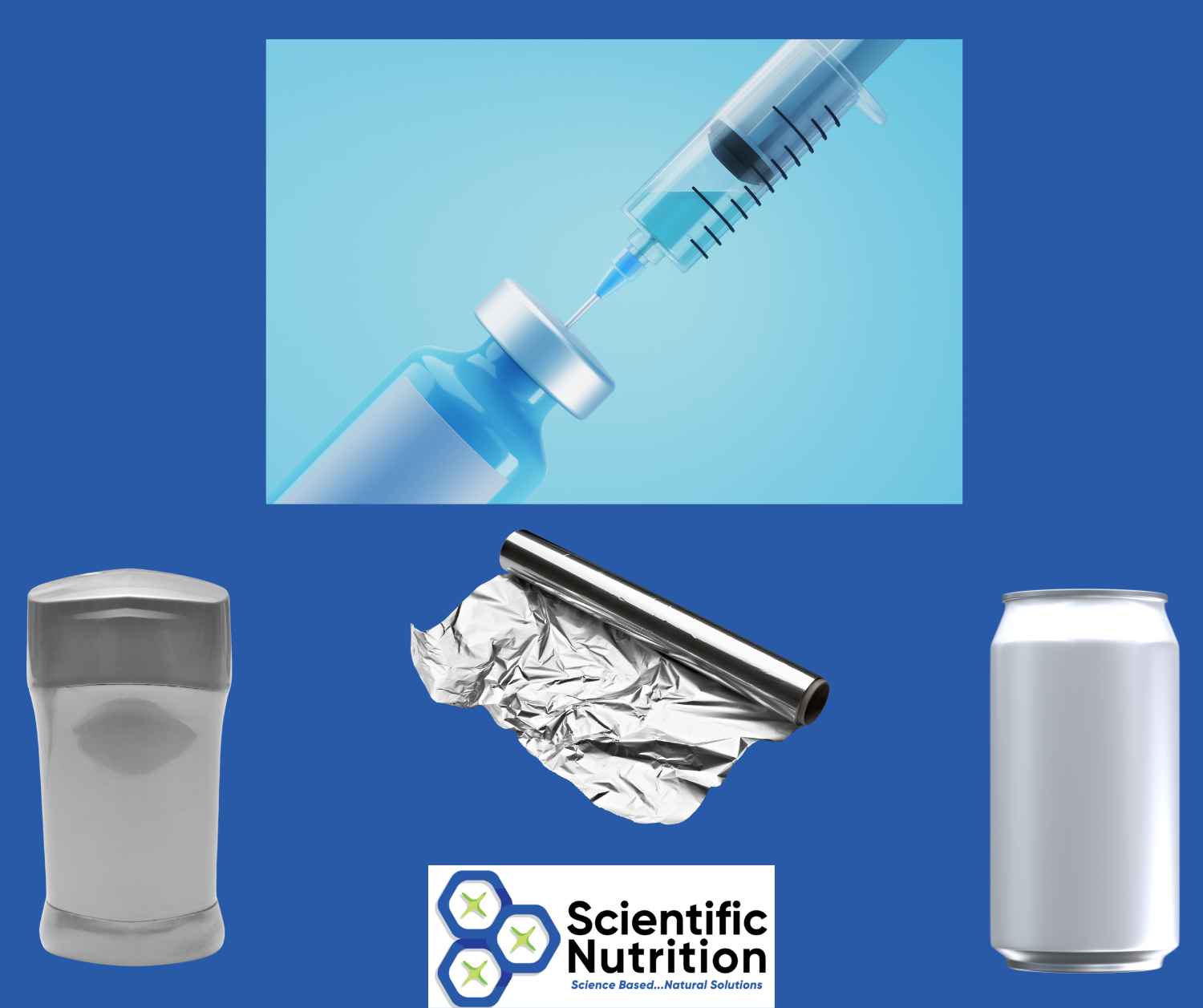Aluminum Toxicity and Your Health
Aluminum is 3rd most abundant heavy metal on Earth. It means that you can’t avoid exposure to aluminum. Reports suggest that everyday exposure is not harmful to your health, but what if this heavy metal excessively penetrates your body?
That’s Aluminum toxicity or poisoning. It’s bad news, but you won’t be able to do your daily activities optimally. This harsh toxicity may affect your lungs, brain, kidneys, heart, and bones.
You might think, “How much aluminum is safe in the body then?”
According to EFSA (European Food Safety Authority), a weekly intake of 1 mg of Al per kg or 2.2 pounds of body weight is safe. In other words, if you are 60 kg (or 132 pounds), the “safe” weekly intake is 60 mg.
Any amount is toxic with no benefit to your health and your body will suffer from it.
Is Aluminum toxic to the human body?
Yes but the truth of its effects is still under addressed.
“A health based maximum contaminant level (MCL) has also not been promulgated for aluminum under the U.S. Safe Drinking Water Act; a secondary non-enforceable MCL has been set at a concentration range of 0.05 – 0.2 mg/L” according to the NIH.
“In general, the adverse health effects from ingested aluminum are not clear. Further research is needed, and EPA has initiated studies which they hope will determine what effects, if any, results from ingestion of aluminum. Aluminum has been linked to some neurological disorders such as Alzheimer’s Disease. There is, however no conclusive evidence that ingested aluminum causes the disease.
In conclusion…In addition to the U.S., aluminum has not been regulated in drinking water by Canada or Europe. Until issues concerning aluminum toxicity (and specifically neurotoxicity) are resolved, the proposed SMCL of 0.5 mg/L is recommended”.
This level was set in 1989!!! Nothing is clear and the government is hoping to determine the effects???
The world has just gotten to be more toxic since. If you follow this guideline you would get 10.5 mg a week by drinking 3 liters daily (average consumption) for a week. If you are not detoxifying, you’ll accumulate 546 mg a year just from your water!
What are safe aluminum levels?
In 2000, the U.S. FDA specified a maximum aluminum concentration of 25 mcg per liter.
Aluminum can be found as a powder or flake component in consumer products such as paint, brewing, fireworks, paper industries, cosmetics such as deodorants, and as coagulants for water purification. It is also found in buffered aspirin, anti-ulcer, and anti-diarrheal formulas, antacids, and medications.
For infants and children, 6 months to 6 years old safety levels is 0.1 -0.3 mg/kg per day
Older children and adults are at 0.1 – 0.18 mg/kg per day
The studies found that the use of citrate (lemon, lime, orange juice) enhances the absorption of aluminum into the gastrointestinal system. Your immune system! Aluminum itself can’t cross your gut barrier but will go through the window with citrate. Citric acid is also an adjuvant that will open the blood-brain barrier so avoid it while detoxifying.
In this blog, I will show you 6 deadly effects I’ve noticed in my previous clients. At the end of the blog, you will read how you get exposed to it and natural ways to detox it.
Read on!
Aluminum toxicity effects on body organs
Usually, your kidneys filter out excess aluminum from the blood. When kidneys are damaged or diseased, they lose their ability to remove it from the body. As a result, it accumulates in the blood and tissues, as well as the brain, bones, liver, blood cells, and heart.
That’s where it destroys your health.
I have divided the 6 effects on 6 body organs that get majorly affected if you have this toxicity.
1. Aluminum toxicity affects your brain health
Al accumulation in the brain happens mostly through the processes of inhalation. Inhalation deposits the heavy metal contents to the lungs and nasal cavity, eventually absorbed into the bloodstream or olfactory nerves. Another way it accumulates in your brain is through vaccinations or certain medications from muscle tissues. ALS (Lou Gehrig’s Disease), Alzheimer’s Disease, Parkinson’s Disease, Dementia, and Autism are some common diseases caused by its accumulation. Memory loss, confusion, fatigue, and cognitive impairments are some of the symptoms that researchers associate with this toxicity.
2. Aluminum toxicity affects your bone health
Aluminum poisoning impedes the normal deposits of calcium and phosphate into your bones. This interference contributes to bone loss and fragility. Various diseases linked to the accumulation in bones are Osteomalacia (demineralized bone with pain), Hungry Bone Syndrome (low calcium after thyroid surgery or metastatic prostate cancer), Osteoporosis (weak or easy to break bones), and Anemia (low red blood cells).
Some aluminum toxicity symptoms associated with its storage in bones include bone pain, tendon rupture, and Pruritus (itching).
3. Aluminum toxicity affects your reproductive health
Increased Al concentration in the body also affects both men’s and women’s reproductive health. This eventually results in impaired fertility, pregnancy failures, and issues with the healthy development of the baby in the womb. Heavy metals may also be deposited into a fetus if the body is at a toxic state as there is no other tissue to store it.
4. Aluminum toxicity affects your liver health
In the liver, Al may induce oxidative stress and damage the liver cells and the bile ducts. These cells help with protein metabolism, detox, immune cell activation, as well as cholesterol and carbohydrate metabolism.
Also, some other diseases associated with aluminum-induced changes in the liver are obesity, type 2 diabetes, and Liver Steatosis. Common symptoms linked to these diseases are increased thirst, frequent urination, fatigue, abdominal pain, and disrupted metabolism.
If you have an exposure, you will eliminate 3 times more aluminum through your bile than your urine within the first 3-4 hours. After that, it is primarily up to your kidneys to dump as much as it can. Since you recycle 2/3 of your bile, keeping the liver clean is a must. I work intensely through internal and external protocols to clear this important organ.
5. Aluminum toxicity affects your kidney health
The pathologies described here appear in two distinct categories: one with the people who have healthy functioning kidneys but cannot flush out this toxic and the latter of people who have failed to excrete Al due to kidney failure.
A sudden loss of kidney function due to accumulation in the tubules causes tubular necrosis, known as acute kidney injury. This can lead to oliguria (low urine output), azotemia (high blood urea nitrogen), and electrolyte imbalances.
At the same time, the damage to a cluster of nerve endings or vessels around the end of your kidney tubule where waste is filtered from your blood. It can develop into Glomerular Disease because the blood vessels can’t clean in the kidney. Another Al toxicity disease is Nephrolithiasis, commonly known as the formation of kidney stones.
On the other hand, impaired renal function causes tubular damage, glomerular sclerosis, and interstitial fibrosis, leading to dialysis or brain infection known as encephalopathy.
6. Aluminum toxicity affects your skin
In the skin, aluminum may cause allergic or irritant reactions, such as contact dermatitis, eczema, and hyper-pigmentation, by triggering the immune system and altering the skin barrier.
It is evident that its delivery hits the different organs in your body through various routes; not all forms or routes of exposure are alike. You must know how you can avoid this toxicity. I recommend specific lifestyle changes to clients that will help to naturally detox Al from your body.
What causes aluminum toxicity?
Aluminum has many uses; it’s widely needed to conduct many activities, but it’s not needed in our bodies. That is why you must know the common sources of this type of poisoning. The toxicity occurs when you become nutritionally deficient and no longer carry the toxins out.
Your diet serves as the main source of exposure, but of course, no scientific reports conclude the clear hazards of supplying Al into human bodies through dietary components. So, the primary routes through which aluminum enters human bodies are as follows.
Aluminum in your diet
Diet serves as the main source of exposure.
- We grow food in contaminated soil.
- We cook food in aluminum-coated cookware.
- We bake with baking soda and baking powder containing this toxic metal.
- We take medications containing aluminum compounds.
- Drinking from a can may be a source of toxicity.
Aluminum in the environment
This toxic metal is widely present in our environment.
- Any aluminum-linked dust-releasing activities, like mixing, grinding, and dumping multiply the exposure concentrations significantly.
- We regularly use it in the construction materials.
- Using Al foil can shed microscopic pieces onto your food when cooking.
- Industrial uses include the manufacturing of automobile components, home products, and explosives.
- Many lawn and garden fertilizers contain this toxic metal. Golf courses are notorious.
Aluminum in personal care products
Your personal care products have many toxic chemicals. Some contributory sources are personal care products, such as cosmetics, sunscreens, and deodorants.
We can’t wish to absorb things into our skin like lotions to moisturize yet “hope” toxic metals in the products above won’t absorb. Our skin is a living organ that needs to be protected too.
Lifestyle changes to adopt to naturally detox aluminum
You can adopt natural ways to detox aluminum from your body. It takes some effort and accountability, but it’s possible.
Here are some of my tried and tested natural ways;
- Drink more silicon-rich mineral water such as Fiji brand or Kiwi Spring Water from New Zealand. It allows silicic acid in the water to enter your body. It then acts as a helping agent for removing this toxic metal and reduces the body’s burden of aluminum.
- Adopt a balanced diet schedule. A balanced diet containing all the essential vitamins, minerals, and antioxidants signals the accumulated Al in your body to leave. You’ll also have the natural energy to detox.
- Use Detoxification remedies such as garlic, parsley, and cilantro. These are helpful herbs that can aid in the detoxification process.
- Change your cooking pots and pans if they are made of this toxic metal. Some eco-friendly and good budget options are 18/0 stainless steel, ceramic, or cast iron pots or utensils.
- Remove junk or processed food from your diet. Beyond the food, it may have aluminum-induced packaging. Processed food can significantly increase the body’s burden.
Hair Analysis for Aluminum Toxicity
Excess of anything is bad. I know it’s a cliche’, but it’s so accurate for this toxic heavy metal. A little can become a big issue. Now that you know how aluminum toxicity impacts your health, some of the related symptoms, sources, and natural detox methods.
LET’S CHAT to explore your health goals and levels of toxicity.
Head over to the FAQs section; I hope you will find some of your answers there too.
FAQs
How do you know if you have too much aluminum in your body?
We all have a small amount in our bodies due to exposure. It becomes problematic when it penetrates your body excessively. Some symptoms, like poor memory, pain in the body, etc., will help you to know if you have a larger-than-normal load.
What is the best test and how is aluminum toxicity diagnosed?
Urine tests, blood tests, and DFO (deferoxamine) tests are some common tests for Aluminum toxicity. There is another lesser-known, most effective natural test that causes you no pain down to the cellular level: Hair Mineral Analysis. As a hair mineral specialist, I can tell you whether you have it in excess or more than one heavy metal toxicity.
Is aluminum toxic for cooking?
Yes. If you cook acidic food in aluminum pots regularly, you may be exposed to a higher level daily. Choose quality steel or glass pots to avoid this exposure.
How can we reduce aluminum toxicity?
You can reduce toxicity by avoiding all aluminum products -containing antacids, antiperspirants, personal products listing it, etc. Look for better alternatives for dialyzate solution used with dialysis (if possible), immunizations, and some total parenteral nutrition (TPN) feeding tube solutions. Choose natural alternatives.
What is a normal aluminum level in blood?
The normal level in your body is less than 10 mcg/L or .01 mg for a normal person. If the person is going through dialysis, it is 60mcg/L or .06 mg. Anything higher than 100mcg/L is toxic.
Further studies and Readings
- https://link.springer.com/article/10.1007/s00775-019-01710-0
- https://www.ncbi.nlm.nih.gov/pmc/articles/PMC8767391/#:~:text=Overdose%20of%20aluminum%20provides%20oxidative,function%2C%20and%20cell%20membrane%20permeability.
- https://link.springer.com/article/10.2165/00002018-200326140-00003
Copyright Scientific Nutrition, LLC 2023




